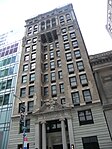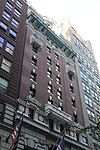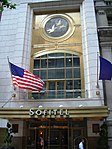Algonquin Hotel
Algonquin Round TableAutograph Collection HotelsHotel buildings completed in 1902Hotels in ManhattanMidtown Manhattan ... and 2 more
New York City Designated Landmarks in ManhattanUse mdy dates from April 2021

The Algonquin Hotel is an American historic hotel located at 59 West 44th Street in Midtown Manhattan, New York City. The hotel is a New York City designated landmark. The 181-room hotel, opened in 1902, was designed by architect Goldwin Starrett. It was originally conceived as an apartment hotel but was quickly converted to a traditional lodging establishment. Its first owner-manager, Frank Case (who bought the hotel in 1927), established many of the hotel's traditions. It had a reputation for hosting numerous literary and theatrical notables, including the members of the Algonquin Round Table.
Excerpt from the Wikipedia article Algonquin Hotel (License: CC BY-SA 3.0, Authors, Images).Algonquin Hotel
West 44th Street, New York Manhattan
Geographical coordinates (GPS) Address Website External links Nearby Places Show on map
Geographical coordinates (GPS)
| Latitude | Longitude |
|---|---|
| N 40.755833333333 ° | E -73.982333333333 ° |
Address
Algonquin Hotel
West 44th Street 59
10036 New York, Manhattan
New York, United States
Open on Google Maps







